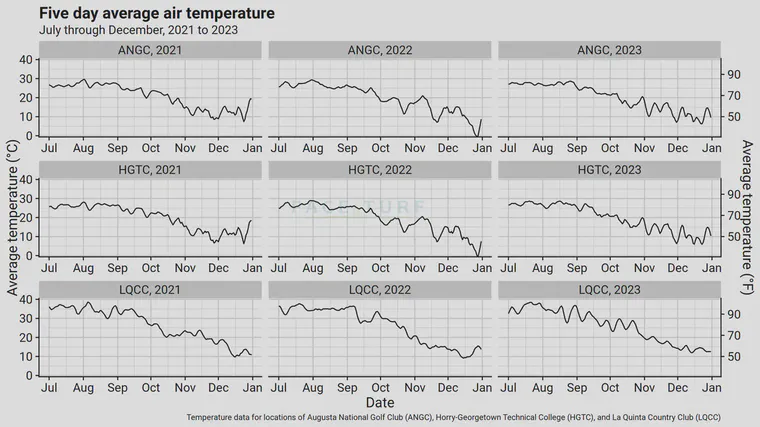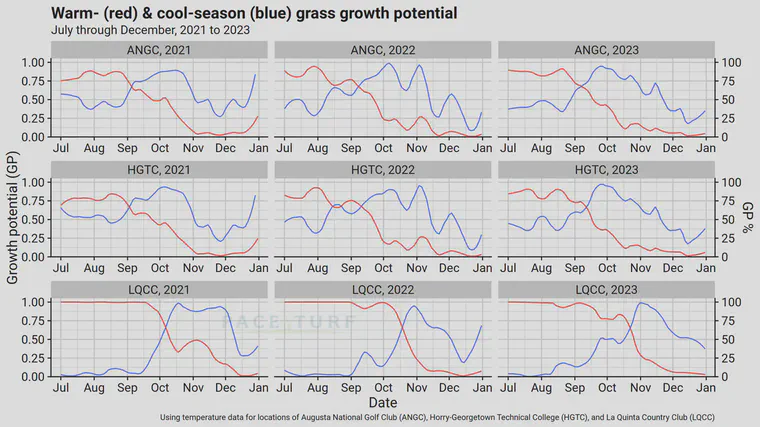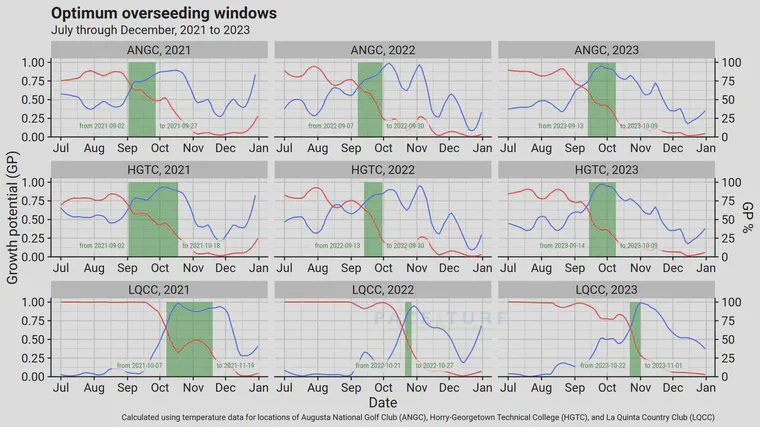Optimum overseeding time windows
I made my first visit to Myrtle Beach two weeks ago for a seminar with the Palmetto GCSA at Horry-Georgetown Technical College. I knew there were a lot of golf courses in the Myrtle Beach area, but until I visited in April and saw all the ryegrass, I didn’t realize that so many courses there overseed in the autumn.
I was curious about the timing of overseeding in Myrtle Beach. The timing of overseeding, anywhere, is often decided for business reasons, or around event scheduling. As far as the grass is concerned, there is an optimum time for overseeding, but that time changes somewhat from year to year based on what the actual temperatures are.

I started by looking up the temperatures for Myrtle Beach, specifically at the Horry-Georgetown Technical College main campus location, along with temperatures at two other locations where overseeding is done—Augusta National Golf Club in Georgia, and La Quinta Country Club in California.

Overseed when it is too hot, and the warm-season grass will outgrow the newly-seeded ryegrass. Wait until the temperatures have cooled too much, and there won’t be enough time for the ryegrass plants to develop prior to the even colder temperatures to come.
The optimum overseeding weather occurs when the cool-season growth potential (GP, developed by PACE Turf) starts to exceed the warm-season GP. Locations that have a suitable climate for overseeding will have temperatures so hot in the summer that warm-season GP exceeds cool-season GP. As temperature cool at the end of summer or in autumn, that flips, and the cool-season GP increases and the warm-season GP drops.
The date when cool-season GP starts to exceed warm-season GP marks the start of the optimum overseeding window.

This date is what I call the inflection point, and I have explained it in relation to Palm Springs overseeding dates. In my previous calculations, I’ve just identified a single date—the inflection point at which the cool-season GP starts to regularly exceed the warm-season GP.1
](/post/optimum-overseeding-time-windows/pace-gp-chart_hu7b9872776e4526662741b770b673940a_208364_4ad707ca841c54afb932d7e45795afe1.webp)
After finding the start date of the optimum overseeding window, one can find the end of it by identifying the date at which the average temperature drops below 20 °C (68 °F). For the chart here, I’ve used the five day average temperature and identified the ending day of the optimum overseeding window as the first day after summer with a five day average temperature less than 20 °C. When the temperatures are dropping, one wants to have seed on the ground and plants growing and maturing.

Identifying these windows of optimal overseeding timing can be useful for planning future overseeding events (based on historical normal temperatures) and for explaining and understanding challenges with overseeding when seed is planted outside of these times.
This occurs at approximately 24.8 °C (77 °F). ↩︎